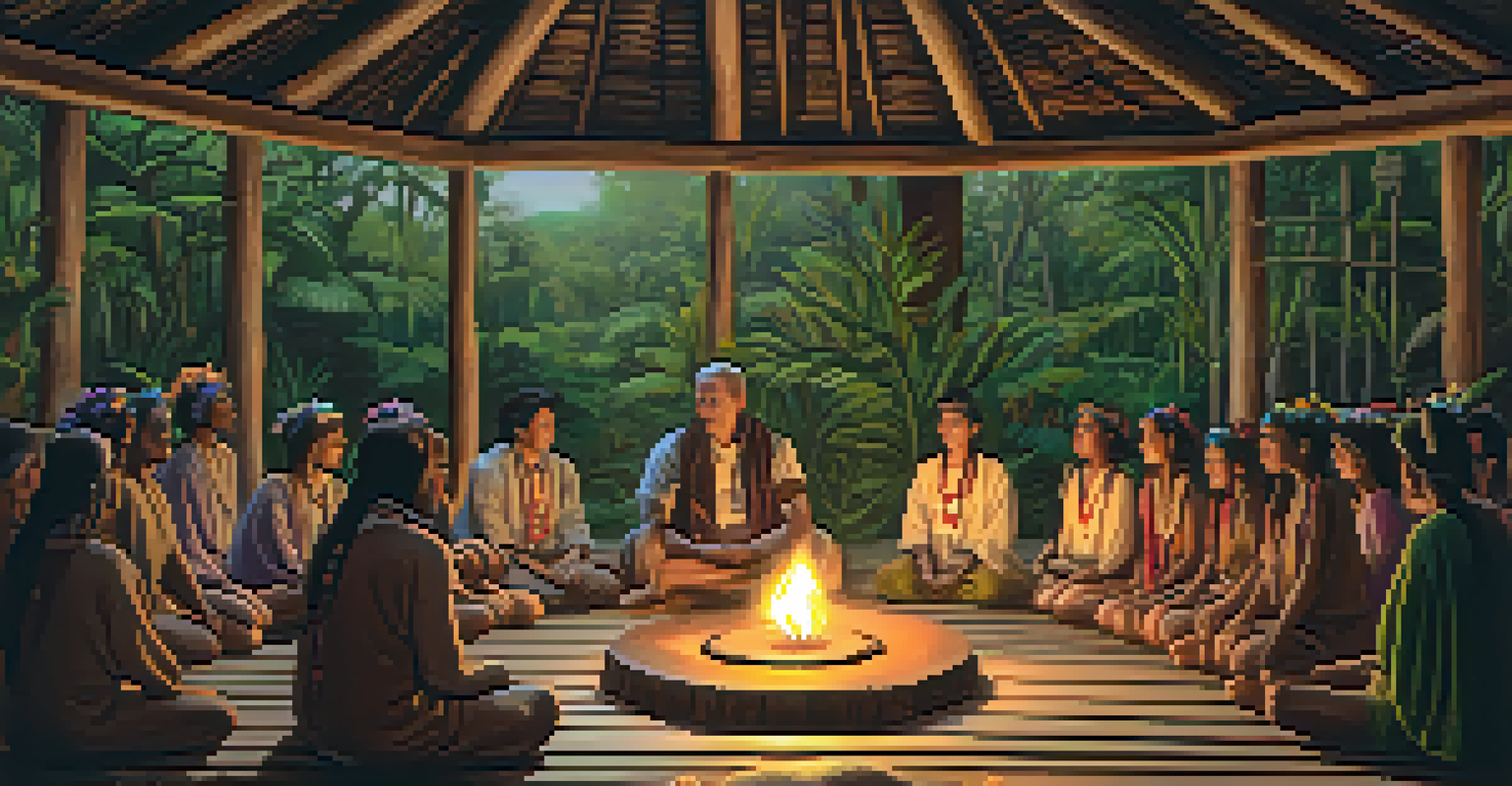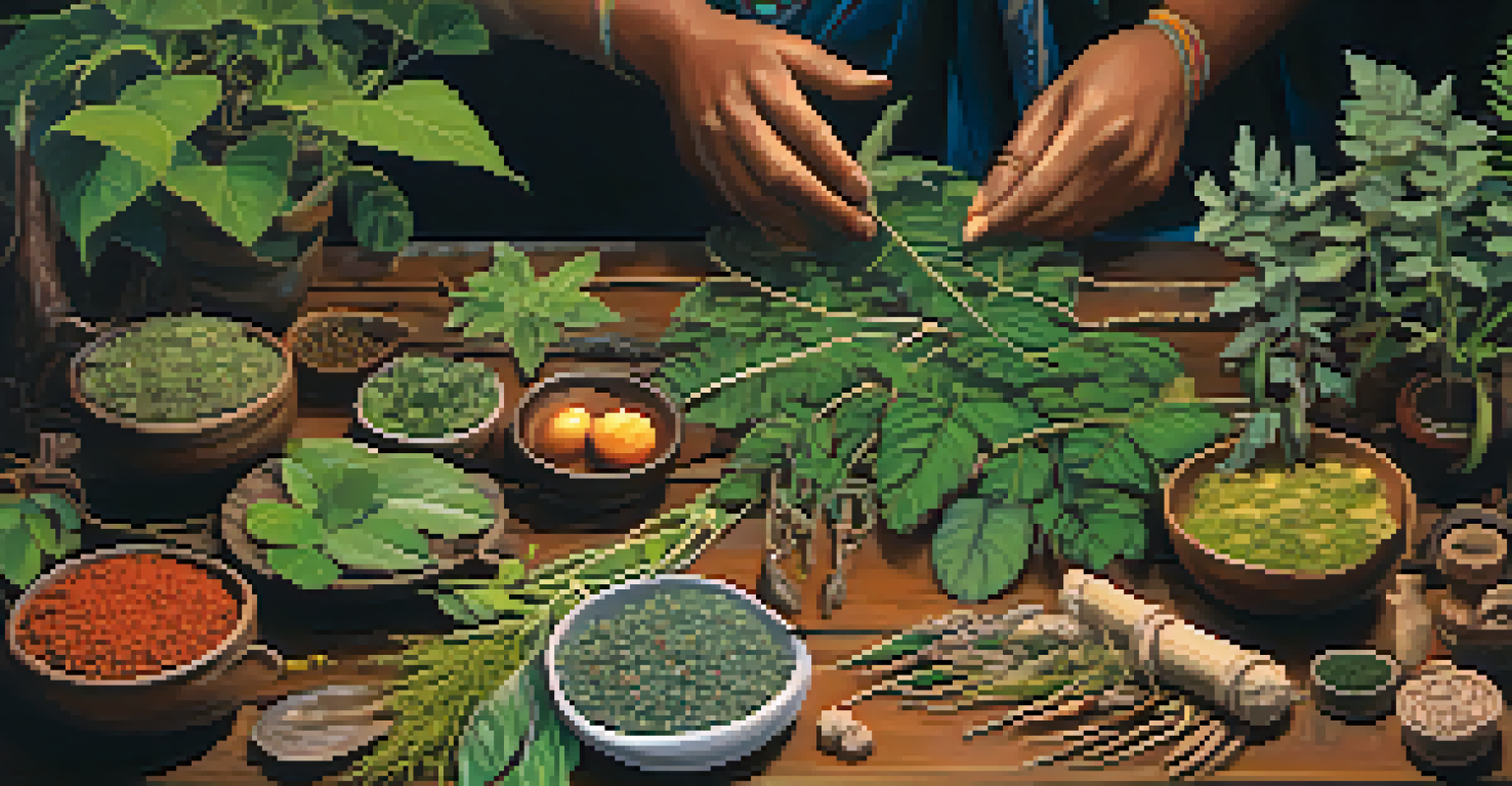The Role of Shamans in Peru's Spiritual Healing Practices

Understanding Shamanism in Peru's Cultural Context
Shamanism in Peru is deeply rooted in the country's rich cultural heritage, intertwining indigenous beliefs with spiritual practices. Shamans, often seen as healers or mediators between the physical and spiritual worlds, play a crucial role in maintaining community wellness. They draw on ancient traditions, often passed down through generations, to provide guidance and healing.
The shaman is the person who has the ability to see what is hidden, to understand the deeper realities of life, and to heal the wounds of the soul.
These practitioners utilize a variety of methods, including rituals, herbal medicines, and spiritual journeys, to address both physical and emotional ailments. In many ways, they serve as the spiritual backbone of their communities, helping individuals connect with nature and their own inner selves. The blend of tradition and spirituality makes shamanism a unique aspect of Peruvian culture.
As modern influences encroach upon traditional practices, shamans work to preserve their methods while adapting to contemporary needs. This balance is essential, as it ensures that the wisdom of the past continues to benefit future generations. Understanding this context is key to appreciating the multifaceted role of shamans in Peru.
The Shaman's Role as a Healer
At the heart of shamanism is the shaman's role as a healer. Using a combination of natural remedies and spiritual practices, they aim to restore balance and harmony within their clients. This involves diagnosing ailments that may stem from physical issues or spiritual disturbances, which are often viewed as interconnected.

Shamans often conduct ceremonies that include chanting, drumming, and the use of sacred plants such as ayahuasca, which is known for its psychoactive properties. These ceremonies provide a space for individuals to confront their fears, traumas, and emotional burdens, leading to profound healing experiences. This holistic approach focuses not only on the symptoms but also on the root causes of distress.
Shamanism's Healing Role in Peru
Shamans serve as healers by using natural remedies and spiritual practices to restore balance and promote well-being.
The transformation that occurs during these sessions can be life-changing. Many participants report feelings of clarity, emotional release, and a renewed sense of purpose after their experience. This emphasizes the shaman's role as not just a healer, but also a guide on the path to personal growth and spiritual awakening.
Rituals and Ceremonies Led by Shamans
Rituals and ceremonies are integral to the work of shamans in Peru. These events often involve the entire community, fostering a sense of unity and shared purpose. Through song, dance, and prayer, shamans invoke spiritual energies to aid in healing and protection.
In the end, we will conserve only what we love; we will love only what we understand; and we will understand only what we are taught.
One of the most well-known ceremonies is the ayahuasca ceremony, wherein participants consume a brew made from the ayahuasca vine and other plants. This experience can lead to deep introspection and insights, often revealing underlying issues that need to be addressed. The shaman guides participants through this journey, ensuring their safety and providing support.
These rituals are not merely for individual healing; they also serve to reinforce community bonds and cultural identity. By participating in these ceremonies, individuals connect with their ancestry and the earth, deepening their understanding of their place within the universe.
The Use of Plant Medicine in Shamanic Practices
Plant medicine is a cornerstone of shamanic healing in Peru, with various herbs and plants used for their medicinal and spiritual properties. Shamans possess extensive knowledge of these natural remedies, often utilizing them in combination with their rituals. This deep connection to nature allows them to harness the healing power of the plants effectively.
For instance, the ayahuasca brew is famous for its psychoactive effects, facilitating profound spiritual insights and emotional healing. Other plants, like chacruna and tobacco, are also commonly used in ceremonies to cleanse and protect participants. Each plant is chosen for its specific properties, reflecting the shaman's understanding of the natural world.
Community-Centric Rituals
Rituals and ceremonies led by shamans foster community bonds and cultural identity while facilitating individual healing.
The respect for these plants is paramount, with shamans often engaging in ceremonies to honor them before use. This reverence highlights the importance of nature in shamanic practices and reinforces the belief that everything in the universe is interconnected.
Shamanism's Influence on Modern Healing Practices
As interest in holistic health and spirituality grows globally, shamanism has begun to influence modern healing practices beyond Peru. Many people are seeking alternative therapies, leading them to explore the techniques and philosophies of shamans. This crossover has sparked a renewed appreciation for ancient wisdom and its relevance in contemporary life.
Yoga, meditation, and other spiritual practices often incorporate elements inspired by shamanic traditions, emphasizing the importance of mind-body connection and personal exploration. The popularity of retreats and workshops centered around shamanic healing has also increased, allowing participants to experience these practices firsthand.
While some may approach shamanism with skepticism, many are finding that these ancient methods offer valuable tools for self-discovery and healing. This blending of traditional and modern practices enriches the wellness landscape, encouraging individuals to explore diverse paths to health.
Challenges Faced by Shamans Today
Despite the growing interest in shamanism, practitioners in Peru face numerous challenges. The commercialization of their practices can dilute the authenticity and sacredness of traditional healing. Some shamans express concern that their ancient knowledge may be misappropriated by outsiders seeking profit rather than genuine healing.
Additionally, the encroachment of modernity and environmental changes threaten the natural resources that shamans rely on for their practices. Deforestation and climate change have significant impacts on the availability of sacred plants, which could undermine the shamanic traditions deeply embedded in the culture.
Modern Challenges for Shamans
Shamans face challenges from commercialization and environmental changes that threaten their traditional practices and resources.
Shamans are also tasked with maintaining their cultural identity in an increasingly globalized world. Balancing the preservation of their traditions while adapting to modern influences is a delicate dance that requires resilience and adaptability.
The Future of Shamanism in Peru
The future of shamanism in Peru is a topic of both hope and concern. As more people seek alternative healing methods, shamans have the opportunity to share their knowledge and practices on a larger scale. This growing recognition can help preserve these traditions and ensure they are passed down to future generations.
However, it is essential to approach this evolution with respect and authenticity. Shamans must navigate the challenges of a changing world while staying true to their cultural roots. This balance will be crucial in maintaining the integrity of shamanic practices.

Ultimately, the resilience of shamanism in Peru will depend on the commitment of both practitioners and the wider community to honor these traditions. By fostering understanding and appreciation, the rich heritage of shamanism can continue to thrive and provide healing for years to come.